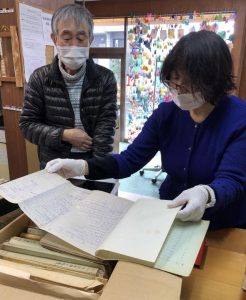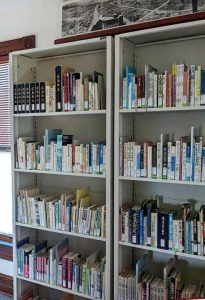HAC’s passion 50 years ago for imparting information on A-bombed Hiroshima, Part 3: Exploring how to preserve, utilize materials in Japan, US
Jul. 27, 2023
Momentum grows for organizing, sharing resources
by Hiromi Morita, Staff Writer
The quantity of materials kept in the Peace Resource Center (PRC) at Wilmington College in the U.S. state of Ohio surprised Junko Hattori, vice chairperson of the World Friendship Center (WFC), a non-profit organization based in Hiroshima’s Nishi Ward. Speaking of her impressions from her month-long stay in the United States earlier this year in February, Ms. Hattori said, “I got the sense that the materials had been sent from Hiroshima based on an intense desire to communicate the information.”
Establishment of the PRC was championed by Barbara Reynolds (1915–1990), an American peace activist and founder of the WFC. Ms. Hattori’s main objective for her trip to America was to discover what had happened to the literature about the atomic bombing that the Hiroshima Appeal Committee (HAC) had sent to the PRC as well as the documents that Ms. Reynolds had brought from Hiroshima and donated to the organization, especially those related to the early period of the WFC.
The PRC, with its Hiroshima and Nagasaki Memorial Collection, was established in 1975. Many related documents remain at the WFC, which took over administrative duties of the HAC after that organization had been disbanded. The paths taken by Ms. Reynolds, someone with great empathy toward A-bomb survivors, and by the citizens of the postwar A-bombed city are likely to emerge in more detail when comparisons can be made between the materials housed at the two centers.
At times, no communication
The materials in Hiroshima had been gathering dust and were nearly forgotten. Similarly, the PRC became more focused on collecting materials related to the issue of conflict resolution rather than on the atomic bombing. Reportedly, there was a time when no communication with the A-bombed city took place.
The situation changed 70 years after the atomic bombing, when Tanya Maus assumed her current position as coordinator of the PRC. At that time, the center returned to its origins, serving as a base in the United States for raising awareness and understanding through the atomic bombings of Hiroshima and Nagasaki about what nuclear war did to humanity. With that, the PRC began to place a renewed emphasis on the preservation and utilization of materials related to the bombings. Around the same time, several people, including Shizuo Tachibana, chairperson of the WFC, took the lead and initiated a project to uncover the postwar history of the A-bombed city and the path taken by people who had gone before. With that, momentum to organize and share the materials grew.
Working to fill voids
Before her return to Japan, Ms. Hattori was able to confirm the presence of materials at the PRC that are missing from the Hiroshima side and discussed ways to share the information with each other. However, the work of filling the voids has just begun.
On the other hand, 400 to 450 people including college students, researchers, artists, and people connected to the media reportedly utilize the PRC archives annually. Ms. Maus said, as Cold War peace activists grow older more and more see the PRC as potential storage space for their documents.
According to Ms. Maus, the materials sent in the past from Hiroshima are now being used in local public programs. One of the initiatives is a half-day vigil that recruits participants for the continued reading of poems and personal accounts written by A-bomb survivors, starting at 8:15 a.m. on August 6. She hopes to make the center into the main depository in the United States for the movement to abolish nuclear weapons and for those working to understand the human suffering caused, and the toll taken, by the use of nuclear weapons.
The WFC continues to organize and study the huge volume of materials held by Hiromu Morishita, WFC’s honorary chairperson. Ms. Hattori emphasized, “That information represents a record of people who worked with Barbara to oppose nuclear weapons in the Cold War era, a time when many people believed that nuclear missiles would keep the peace. People now have to work just as hard to utilize the information.”
The materials documenting the history of the HAC’s represent a fragment of the postwar grassroots history of the A-bombed city. The collection of materials, which conveys the passions from half a century ago, asks how the modern A-bombed city will face those fragments of information.
(Originally published on July 27, 2023)









